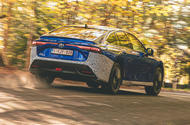Toyota’s Mirai is one of a few hydrogen cars on the market
The Toyota Mirai is powered by gas, spurning conventional electric wisdom – but there are industries for whom batteries don’t really work
Curious. The subject of a hydrogen fuel cell car like the Toyota Mirai has, like caravans or cyclists, a peculiar ability to create arguments where people are desperate to be *right*.
Common opinion has it that hydrogen is going nowhere. Battery-electric cars are more efficient: you don’t have to expend vast amounts of energy to produce a fuel and then freight it to a car, only to turn it into electricity again.
Why would you go to the expense, trouble and inefficiency once you’ve generated power in the first place? Just stick it in a battery.
“If you approach it from the point of sustainability,” one senior car industry exec told me, “battery-electric cars are better.” Volkswagen CEO Herbert Diess said much the same last year, albeit at the launch of the ID 3 battery-electric car.
Besides, electric wires are everywhere, whereas hydrogen filling stations are not. Far from all hydrogen production is green, and we’re getting better at making battery-electric vehicles all the time. Batteries will even work for trucks, depending on the duty cycle.
But? Well, there are buts. There are industries for whom batteries don’t really work. The European Federation for Transport and Environment, which has no skin in any particular game other than a zero-emissions one, thinks that with aviation and shipping there is no carbon-free alternative to hydrogen.
For trucks or machinery that covers vast distances or enjoys precious little downtime, the extra expense and relative inefficiency may also be worth it, to keep a machine on the move.
China is investing in hydrogen deeply and domestic hydrogen trials, to replace natural gas boilers and cookers, will shortly begin in Scotland.
In other words, there is a groundswell of movement like there hasn’t been before. In July, the EU committed to scaling up renewables-based hydrogen for sectors where there are no alternatives.
“This is the right plan at the right time,” said the Federation for Transport and Environment. “Hydrogen is the missing link in Europe’s strategy to decarbonise planes and ships where electrification is not an option.”
For most of us, of course, electrification will be an option. We won’t drive far enough to expend batteries and our cars will spend long enough parked that there will be plenty of time to charge them.
But the same may not be true for all of us. And once you’ve created a structure for ports, airports, truck and even rail depots, it’s not too much of a stretch to imagine adding van and passenger car vehicle filling stations.
It won’t be for everyone. But acknowledging that cars like the Mirai, and those that will follow it, can represent another alternative does not dilute the appeal of battery-electric vehicles. It merely gives more options, which will make life for the motorist even better. I have no skin in the game other than that.
READ MORE
Analysis: is there a place for hydrogen in motoring?
Hydrogen cars explained: the technology targeting a fuel-cell future
Source: Autocar
